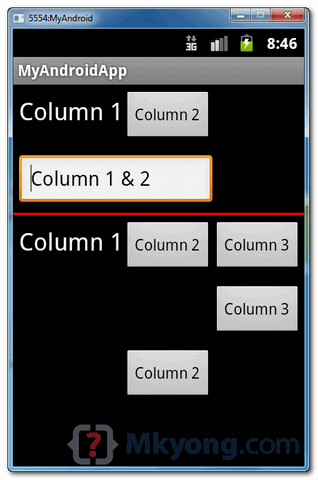In Android, TableLayout let you arranges components in rows and columns, just like the standard table layout in HTML,
<tr> and <td>.In this tutorial, we show you how to use
TableLayout to arrange button, textview and edittext in rows and columns format, and also demonstrates the use of “android:layout_span” to span view in 2 cells, and “android:layout_column” to display the view in specified column.Note
In Eclipse 3.7, XML code assist will not prompts the attribute “
In Eclipse 3.7, XML code assist will not prompts the attribute “
android:layout_span“, “android:layout_column” and many other useful TableLayout attributes, no idea why, may be bug. Just put the attribute inside, it’s still compile and run.P.S This project is developed in Eclipse 3.7, and tested with Android 2.3.3.
1. TableLayout
Open “res/layout/main.xml” file, add following views for demonstration. Read the XML comments, it should be self-explanatory.
File : res/layout/main.xml
<?xml version="1.0" encoding="utf-8"?>
<TableLayout xmlns:android="http://schemas.android.com/apk/res/android"
android:id="@+id/tableLayout1"
android:layout_width="fill_parent"
android:layout_height="fill_parent" >
<!-- 2 columns -->
<TableRow
android:id="@+id/tableRow1"
android:layout_width="wrap_content"
android:layout_height="wrap_content"
android:padding="5dip" >
<TextView
android:id="@+id/textView1"
android:text="Column 1"
android:textAppearance="?android:attr/textAppearanceLarge" />
<Button
android:id="@+id/button1"
android:text="Column 2" />
</TableRow>
<!-- edittext span 2 column -->
<TableRow
android:id="@+id/tableRow2"
android:layout_width="wrap_content"
android:layout_height="wrap_content"
android:padding="5dip" >
<EditText
android:id="@+id/editText1"
android:layout_span="2"
android:text="Column 1 & 2" />
</TableRow>
<!-- just draw a red line -->
<View
android:layout_height="2dip"
android:background="#FF0000" />
<!-- 3 columns -->
<TableRow
android:id="@+id/tableRow3"
android:layout_width="wrap_content"
android:layout_height="wrap_content"
android:padding="5dip" >
<TextView
android:id="@+id/textView2"
android:text="Column 1"
android:textAppearance="?android:attr/textAppearanceLarge" />
<Button
android:id="@+id/button2"
android:text="Column 2" />
<Button
android:id="@+id/button3"
android:text="Column 3" />
</TableRow>
<!-- display this button in 3rd column via layout_column(zero based) -->
<TableRow
android:id="@+id/tableRow4"
android:layout_width="wrap_content"
android:layout_height="wrap_content"
android:padding="5dip" >
<Button
android:id="@+id/button4"
android:layout_column="2"
android:text="Column 3" />
</TableRow>
<!-- display this button in 2nd column via layout_column(zero based) -->
<TableRow
android:id="@+id/tableRow5"
android:layout_width="wrap_content"
android:layout_height="wrap_content"
android:padding="5dip" >
<Button
android:id="@+id/button5"
android:layout_column="1"
android:text="Column 2" />
</TableRow>
</TableLayout>
2. Demo
See result.

Download Source Code
Download it – Android-TableLayout-Example.zip (15 KB)
No comments:
Post a Comment